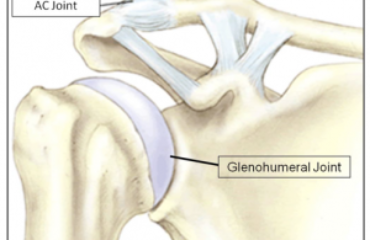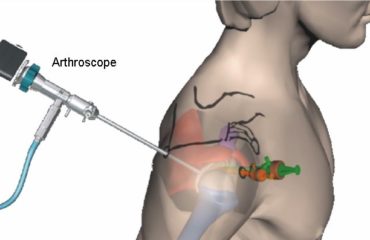Reverse shoulder arthroplasty (also known as RSA) was developed in Europe in the late 1980s, in order to treat rotator cuff joint abnormalities in conjunction with degenerative arthritis of the shoulder. Only approved by the FDA in 2004, RSA has significantly improved rotator cuff and arthritis treatments.
It has the potential to successfully treat insufficiencies of the rotator cuff in a wide range of shoulder conditions. RSA relieves pain and restores functioning in many patients suffering from rotator cuff conditions. Studies indicate that 96 percent of patients evaluate their level of postoperative pain relief as good. Normally a shoulder replacement done normally works well, but if the rotator cuff is insufficient range of motion will suffer. RSA addresses this problem.
This surgical procedure reverses the ball and socket type joint’s natural anatomy. It accomplishes this by successfully  implanting a concave socket plate into the head of the humerus and a convex component into the glenoid fossa (shallow articulating surface on the lateral edge of the scapula).
implanting a concave socket plate into the head of the humerus and a convex component into the glenoid fossa (shallow articulating surface on the lateral edge of the scapula).
Advantages and Disadvantages of RSA
Advantages of reverse shoulder arthroplasty:
- More consistent pain relief (from replacing both portions of the shoulder joint)
- Restores active elevation of the shoulder
- Improves stability of the shoulder
- Faster recovery period (usually only a single night stay in hospital)
Disadvantages of reverse shoulder arthroplasty:
- Rates of reported complications vary, reflecting rapid adoption of a technically challenging surgery.
- This procedure may be seen as the solution to all problems of the shoulder, which were previously considered untreatable. This is not really a disadvantage though.
Complications and Short Term Outcomes with RSA
Complication rates seem to be extremely variable with reverse shoulder arthroplasty. Some reports indicate complications in as many as 50 percent of cases. This wide variation may partially be explained by the fact that RSA is often performed as a last resort for failed prostheses. It is also commonly used as a surgical option in elderly patients who have poor quality bones.
Possible complications and short term outcomes of RSA surgery include:
- Dislocations
- Infections
- Fracture ultimately considered inoperable
- Brachial plexopathy (disorder which affects a network of blood vessels, nerves, and lymph vessels)
- Acromial (bony process of the shoulder blade) stress fractures
- Glenoid (articulating surface on the edge of the scapula) notching
- Multiple types of mechanical failure
At many advanced American orthopedic clinics, rates of complications involved with RSA are typically reported to be less than 10 percent. While these centers may possess short term outcomes that are  promising, reverse total shoulder arthroplasty is still a relatively new surgical procedure within the U.S.
promising, reverse total shoulder arthroplasty is still a relatively new surgical procedure within the U.S.
Dr. Adam Farber at Phoenix Shoulder and Knee is a Board Certified, Fellowship Trained orthopedic surgeon with extensive experience in reverse shoulder arthroplasty. As an orthopedic doctor Phoenix trusts, Dr. Farber treats patients with compassion and skill in the most minimally invasive way possible. He also performs platelet rich plasma therapy for nonoperative pain relief.




